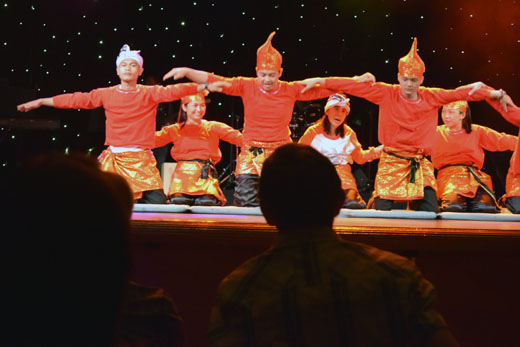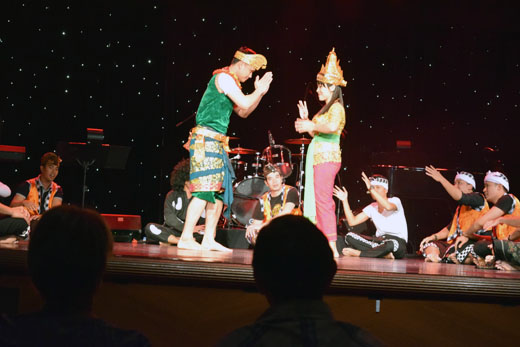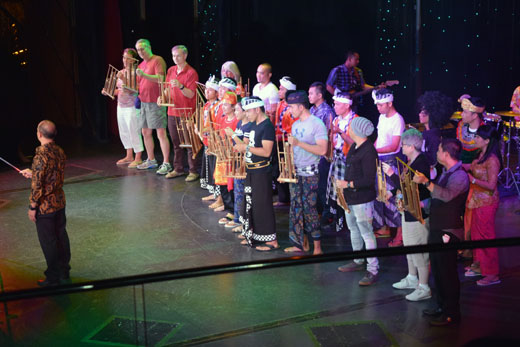Editor’s Note: This is the twelfth in a series of stories researched during Don and Nancy Harrison’s 50th Wedding Anniversary cruise from Sydney, Australia, to San Diego. Previous installments of the series, which runs every Thursday, may be found by tapping the number of the installment: 1, 2, 3, 4, 5, 6, 7, 8, 9, 10, 11
By Donald H. Harrison

AT SEA, Aboard MS Maasdam – On our second day out of Tasmania, nearing New Zealand, we were treated to an Indonesian crew show at which we had a rollicking good time learning a little bit about the culture of our waiters’ and cabin stewards’ home country.
These were by no means professional dancers, and perhaps in their home country they could at best be contestants on whatever Indonesia’s equivalent of the old Ted Mack Amateur Hour might be. Before the delighted eyes of MS Maasdam’s passengers, however, the enthusiastic cast members appeared as trained terpsichorian ambassadors, performing for us the Thousand Hands Dance (actually about 980 hands short of that total); a rescue scene from a well-known Hindu epic poem; and a symphony in percussion played on angklungs.

In the Thousand Hands Dance, better known in Indonesia as the “Saman,” dancers take their positions across the stage, kneeling as they face the audience. Then to singing, rather than to instrumental accompaniment, the dancers move their arms, hands, heads, and shoulders in an alternating pattern, so, for example, when one performer is seated in a low position, the performers on either side of him are rising to positions higher than him, and vice versa.
The purpose of the hypnotizing dance, in addition to entertainment, is to demonstrate what wonderful things may be done when people cooperate with each other.

A bit later in the program we saw what the crew called “the Monkey Dance,” because, as is told in the Hindu Ramayana, a “monkey king” abducts Princess Sita, but she is later rescued by the divine Prince Rama. As this ritual dance proceeds, it is accompanied by the chattering of many cast members, all of them imitating the call of a macaque. Popular on the island of Bali, where many Hindu people live, the dance is not only fun to watch, but provides an opportunity for the cast to show up some splendid costumes.

Near the end of the show, we had a demonstration by an “angklung” orchestra – that is, the same group of cast members who now were playing instruments made from bamboo tubes and bamboo frames. As the conductor pointed to a chart, different musicians shook their angklungs, creating a percussion sound that might be compared to that of a xylophone.
After demonstrating the technique, the crew brought audience members onto the stage, gave them each an angklung, and led them through the identical melody. While some audience members looked a little bit sheepish up there, most got right into the rhythm of things, and won, along with their Indonesian teachers, a healthy round of applause from their fellow passengers.
Some of them, in fact, became minor “celebrities” as they made their way from one activity aboard the Holland America ship to another. “I know you—you’re the angklung player, aren’t you?”
Later in the cruise, we were informed, there also would be a Filipino Crew Show, featuring the dances of the multi-island Philippines.
The crew members who perform in the shows do not receive anything extra, except perhaps for some time off their regular jobs in order to rehearse. But you can feel their joy as they do these happy dances. On stage, they express the hope that the cruise ship passengers some day will make it a point to visit their country, in which they take so much pride.
*
Harrison is editor of San Diego Jewish World. He may be contacted via donald.harrison@sdjewishworld.com
Pingback: Cushion stars and tuataras in Picton, N.Z. | San Diego Jewish World
Pingback: Route to New Zealand was a sound decision | San Diego Jewish World
dating online here “http://snapcoin.ru/” – dating site http://atomioptic.ru/